
Page 4
http://threesology.org
Note: the contents of this page as well as those which precede and follow, must be read as a continuation and/or overlap in order that the continuity about a relationship to/with the typical dichotomous assignment of Artificial Intelligence (such as the usage of zeros and ones used in computer programming) as well as the dichotomous arrangement of the idea that one could possibly talk seriously about peace from a different perspective... will not be lost (such as war being frequently used to describe an absence of peace and vice-versa). However, if your mind is prone to being distracted by timed or untimed commercialization (such as that seen in various types of American-based television, radio, news media and magazine publishing... not to mention the average classroom which carries over into the everyday workplace), you may be unable to sustain prolonged exposures to divergent ideas about a singular topic without becoming confused, unless the information is provided in a very simplistic manner.
Clearly, while we can identify enumerated similarities between multiple subjects, one must eventually contend with the notions of strategy and cleverness, though words such as complexity and context may be used as a tool by which a suggested measurement of importance is alternatively advanced under a banner of increased intelligence. For example, no matter the arrangements of players, no matter the amount of money or seriousness of participants; games of sports are viewed as silly activities by many people. In fact, some observers think that such activities represent more ignorance than any intellectual advancement in the species. Similarly, the games of chess, poker and billiards with their varying degrees of employed strategy and diminished forms of physical activity... are also indicative of minor levels of expressed intelligence. Then again, the definition of intelligence is being left up to those who may be describing a different type of intelligence.
Let us ask if the pursuit of an Artificial Intelligence is a repeat of history in the guise of different garments? While each generation likes to view itself as more capable and intelligent than a predecessor, is this actually the case? Has each successive hominid species been more intelligent than a predecessor who may or may not share the same time zone as Cro Magnons and Neanderthals are now thought to have shared some contemporaneous living sphere? Is each species more relevant to a given period of time because for one reason or another it can more easily exploit available raw materials of a given environment? Are we looking at a mere difference of foraging behavior based on an underlying activity of generality akin to a fishing or other fortune hunting expedition? Are ancient orientations of generality expressing themselves in present day contexts with different labels and applications that obscure the realization of mere repetition concealed in the guise of some modern language labeling? Are AI researchers little more than minor philosophers using tools of examination that appeared in a distant past but are now labeled differently in a context being described as innovative... and thus everything being applied to it is also automatically interpreted as being innovative?
Top Down AI appliers want to draw a circle in the sand, but if there is no sand— no circle can be drawn even amidst the availability of paper or a chalk board. The "rules and knowledge" programming rely on repetitious occurrences of a set of rules and regulation. Top Down approaches are not typically enabled to go outside the box and use whatever materials are available. They are not generalists, they are 'specificits'... where a hammer is good for only one thing and that is to hammer nails. No other function is permitted because it is not written in the program. Anything external to the parameter of the rules is not seen... like blinders put on a horse. Their's is a stoic philosophy on all accounts.
Bottom Up AI appliers want to stand in the sand that is (unknowingly) placed into a box which does not readily fit into a circumscribed circle. It's system of generalization is itself a specificity programmed by the limits of the programmers whose attempt to draw outside the lines have imposed their belief of where the lines are. A limitation in the depth of their broadened philosophical pursuit can quickly be discerned.
Neither Top Down nor Bottom Up AI researchers have an adequate definition of intelligence. Typically, the definition is constrained to conform to that which is produced by their efforts to great some semblance of human activity via a computer-assisted machine, and often resembles an anthropomorphism such as someone who compares the two head lights of a vehicle with the eyes of a human and the grille with a grin, face, or set of teeth. And yet, it is not yet certain whether anything humans do is actually an act of "intelligence" in terms of being an entity existing without the need for physiology responsive to various environmental stimuli that is absorbed, translated and then expressed in some manner. Because of such, we must wonder if instinct or reflex are expressions of intelligence? Do we simply refer to them as different types of intelligence or seek to ascertain some more definitive and purer definition?
So what if a robot can respond to internal or external stimuli like humans and other life forms. Such activity in no way describes intelligence... unless intelligence is accordingly defined because we humans say so; due to the realization that the definition of intelligence is just as limited as is our presumed level or type of intelligence. "Human Intelligence" thus becomes little more than a type of defined intelligence, which may be an incorrectly identified behavior which has cropped up like an itch, or the twitch of an involuntary muscle jerk. What makes humans think or feel they are intelligent? Is it simply a matter of measurement... and thus add the word "intelligence" to some singled out spectrum of accomplishment or desired goal... with "greater" intelligence denoted by infrequency of appearance?
And so what if we are able to design a robotics system to take over every single social function so that humans were employed only in artistic or intellectual arts. Is this intelligence? Are humans actually intelligent, or are they only defining themselves as such because of an over-inflated ego so reminiscent in the "chosen one", "chosen people", or "chosen place" ideology of religious orientation? Just because businesses can cheat the public out of money does not mean this an action of intelligence. Nor does the ability to manipulate or seduce. And yet, in so saying, have we thus made the word "intelligence" into a myth, a fairy tale, an item for which those with a penchant for Quixotic adventures will quest in vain for? Clearly, what we discover is that AI researchers are lousy philosophers.
(I used the word "lousy" in the above paragraph not as a disparagement, but as a motivator... to step beyond current paradigms.)Is a person intelligent because they can speak several languages due to being subjected to a language environment requiring the adoption of such a behavioral array? What then are we to make of those feral children who loose the capacity for "normal" language because they were not subjected to language during a critical language-development stage? Just because someone is good at a certain task does not mean they are intelligent. People can be trained to exhibit behavior which gives the impression of being intelligent... based on a given set of rules another person has incorporated into their repertoire of knowledge. Is intelligence to be defined by trainability? Is the flexibility of a contortionist to be described as an intelligent act? Does making a lot of money in a given context where money is valued? Is a person to be automatically endowed with especial intelligence because they get elected to some political office, or is this idea part of a system of social propaganda used by those who want to conceal their actual mediocrity behind contrived illusions? And what about playing chess? Are chess players more intelligent than others? What can be learn from the architecture of chess in which to analyze this thing we are calling intelligence? Let's take a short walk in this area:
2 rows of 8 game pieces3 directions (horizontal, diagonal, vertical)
8 X 8 = 64 squares
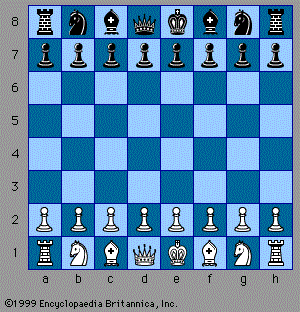
Because there is a frequent reference to the game of chess when referring to intelligence, the game of chess needs to be reviewed from a 3sological perspective in order to reveal it is a three-patterned maze that the human brain has been placed like a rat or mouse. For example, like checkers, chess permits a player to move pieces in the three directions known as diagonal, horizontal and vertical. This outline is like a syllogism (silly-gism): All cats have eyes. kate is a cat. Therefore kate has eyes. When the route of play is known, knowing the route is not the same as taking it or remembering to take it at a given turn. Is intelligence to be described because of memorization? And what if the route to a win is accomplished by way of an accident? Are we to say this is an indication of hidden or latent intelligence, and then use some sort of rationalization to give it greater meaning such as describing it as a type of intelligence needing a given environment?
And what if we were to describe Chess as an expression of being little more than a projected image of a three-patterned framework existing in our brain or biology... and is therefore to be considered a basic illustration of an intelligent design? Such that, for example, the 64 squares of a chess board is to be compared to the same number of amino acids for DNA and RNA, creating a parallel distinction as an artistic thought experiment. ("Words" and "squares" are symbolically inter-changeable. Imaginative thinkers do not have a problem with the interchange, only those who engage in the practice of narrowly defined associations. Analogously configured, the word "hammer" can be alternatively used to describe multiple ideas that can be increased by mixing or deleting any of the letters of the word.)
In humanity's early attempts to unravel the genetic code, it was determined that in order for us to account for the 20 amino acids used in the synthesis of most proteins, there would have to be a code that would, at its very minimal, contain at least 20. As can be seen in the following chart, a singlet code would only provide us with 4 amino acid "words," and a doublet code would only provide us with 16 "words." It is obvious that both of these code formulas fall short of the minimum requirement of 20, but that a triplet code satisfies this need quite easily by having a 64 "word vocabulary":
| Singlet code (4 "words")
|
Doublet code (16 "words")
|
Triplet code (64 "words")
|
| A | AA/AG/AC/AT | AAA/AAG/AAC/AAT |
| G | GA/GG/GC/GT | AGA/AGG/AGC/AGT |
| C | CA/CG/CC/CT | ACA/ACG/ACC/ACT |
| T | TA/TG/TC/TT | ATA/ATG/ATC/ATT |
| GAA/GAG/GAC/GAT | ||
| GGA/GGG/GGC/GGT | ||
| GCA/GCG/GCC/GCT | ||
| GTA/GTG/GTC/GTT | ||
| CAA/CAG/CAC/CAT | ||
| CGA/CGG/CGC/CGT | ||
| CCA/CCG/CCC/CCT | ||
| CTA/CTG/CTC/CTT | ||
| TAA/TAG/TAC/TAT | ||
| TGA/TGG/TGC/TGT | ||
| TCA/TCG/TCC/TCT | ||
| TTA/TTG/TTC/TTT |
Source: Genetics, Music, Logic
Each of the triplet associations makes up an individual grouping to produce 64 squares. 64 "words" in genetics and 64 squares in checkers and chess. For some the analogy is nothing more than a numerical correlation, for others it presents them with a recurrence beyond mere coincidence. However, in the following illustration, I placed the 64 triples in the aligned configuration of the four-square game whose spaces measure eight feet by eight feet and the numbers (here) are arranged in a clockwise fashion. the angled lines represent the spot from which a player positioned in the box is supposed to serve the ball. Imagery often overlaps multiple subject areas. The correlations are easier if everyone in a discussion are familiar with the different subjects... otherwise, detailed explanations can interrupt the landscape being drawn out. And if a game were to be constructed using multiple references from a variety of subject areas, would the involvement represent more... or less intelligence, if an indication of intelligence at all? The recurrence of the numerical points of reference seem to be more of an echo that can be referred to as an instinct, if it is attributed with some species' modus operandi (mode of operating for survival); and thus attributed with more value than a behavior such as intellectualized creative thinking whose value may not be appreciated by a given reader at a given time.
Note: I arranged the amino acids in the order of playing cards with a partner who may sit opposite from you. In other words, instead of having the "G" series follow the "A" series as disclosed in the previous listing of amino acid words, I placed each diagonally opposite from one another.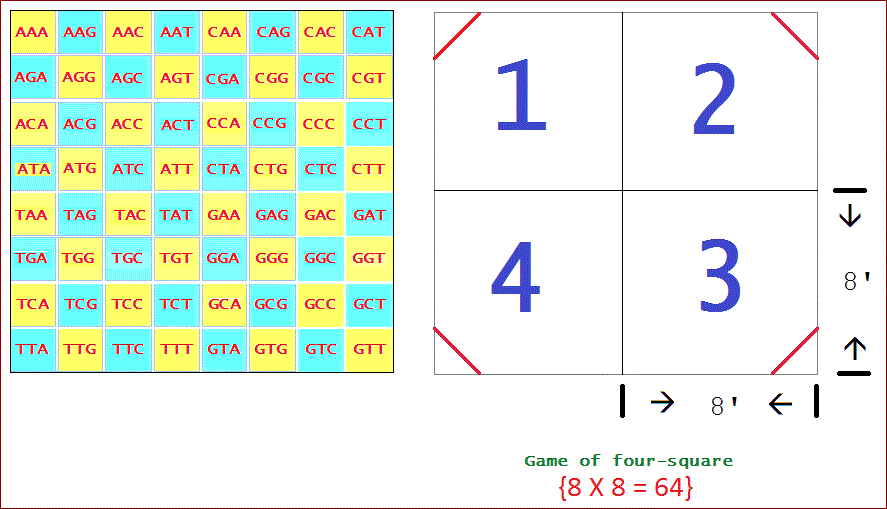
No less, what then if we describe the three directions used in checkers and chess as a type of triple code in which a certain number of game pieces can be moved about, just like a certain number (kind) of amino acids can be moved about which utilize a triplet code? Do we thus continue in the analogy and try to interpret the kind and/or number of pieces as being representative of some intimated correlation that only a chess or checker-playing geneticist can come to appreciate by applying the imagery of a poet? And then if we couple this analogy with a comparison to the "checkered" board of particle physics, are we seeing yet another extension of a 3sological characterization needing a much larger model for appreciating a greater design, whether we call it intelligent or not?
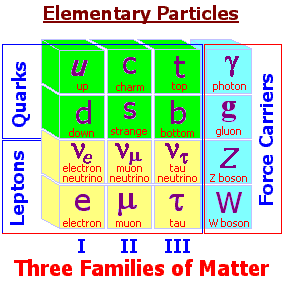 |
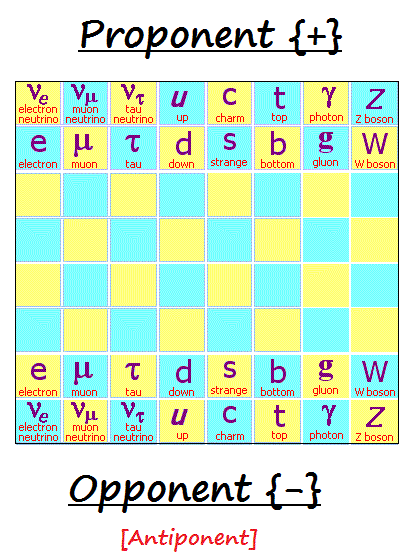 |
Again and again, as our ambitions to reach beyond the known to the known reveals that we have outstripped our technology... making it necessary to create anew with different models which reveal unrecognized trails sometimes found serendipitously while chasing the fireflies of imagination. The need for exploring different perspectives by way of different intellectual models is only surpassed when we produce an artificial representation in a practical form... or formula... from which we can architect a plan of action to achieve that presently being imagined.

And speaking of architectural layouts, using a wooden pallet as a game board, items such as boxes are frequently set into an alignment which will "lock" the boxes into place, just like amino acids are "locked" into place by being arranged according to the amino acid in question. While pallets come in a variety of sizes, many of which are made-to-order for a specific transport purpose, a typical pallet in many warehouses have at least one 4 foot dimension. And though the number of "slats" used in creating a base for products differ according to the size of the pallet; in order to facilitate ease of movement to and from trucks, there are two slots incorporated at the bottom which enable them to be moved by forklifts, pallet jacks or some other suitable devise. Though pallets with boxes may be shrink-wrapped, stretch-wrapped and/or banded afterwards for making a journey along different routes, the same sort of insurance sealing is not readily seen as an analogy by biologists or geneticists in terms of a cell membrane unless it is pointed out.
Of the top pallets used in North America, the most commonly used by far is the Grocery Manufacturers' Association (GMA) pallet, which accounts for 30% of all new wood pallets produced in the United States. The ISO also recognizes the GMA pallet footprint as one of its six standard sizes.
| Dimensions, mm (W × L) | Dimensions, in (W × L) | Production Rank | Industries Using |
|---|---|---|---|
| 1016 × 1219 | 40 × 48 | 1 | Grocery, many others |
| 1067 ×1067 | 42 × 42 | 2 | Telecommunications, Paint |
| 1219 × 1219 | 48 × 48 | 3 | Drums |
| 1219 × 1016 | 48 × 40 | 4 | Military,[4] Cement |
| 1219 × 1067 | 48 × 42 | 5 | Chemical, Beverage |
| 1016 × 1016 | 40 × 40 | 6 | Dairy |
| 1219 × 1143 | 48 × 45 | 7 | Automotive |
| 1118 × 1118 | 44 × 44 | 8 | Drums, Chemical |
| 914 × 914 | 36 × 36 | 9 | Beverage |
| 1219 × 914 | 48 × 36 | 10 | Beverage, Shingles, Packaged Paper |
| 889 × 1156 | 35 × 45.5 | Unknown | Military 1/2 ISO container, fits 36" standard doors[5] |
| 1219 × 508 | 48 × 20 | Unknown | Retail |
Source: Wikipedia: Pallet
Similarities of cognitive efforts take place in may subject areas such as palletizing boxes or laying tiles out:

Source: Tile Patterns
However, for some readers... they are unable to easily visualize the atomic particles arrayed as game pieces upon a 64 square board that is highlighted with the notions of particles "against" their anti-particle reflections... much less as being arranged as boxes on a pallet or tiles set in some tiled organization. If their minds do permit them the occasional foray into analogical generalities, it is only because they have been instructed to do so. While such people are good at mastering someone else's flights of imagination, in order to get a Master's Degree in some subject area, they are not equipped with the cognitive skills to pursue their own creative, and perhaps novel research that doesn't like to be constrained by the observed conventions of intellectual inquiry... of which those involved in Artificial Intelligence know all too well they are engaged in blazing trails.
As such, I have taken the imaginative liberty (creative license) to illustrate an image of atomic particles arrayed in a chess board fashion, in order to provide a clearer picture of the analogy being made. Whether or not a reader will accept it in a literal sense is not the intended point being made. Just because the previous particle image arrayed the particles on a small board doesn't mean we have to refrain from increasing the view with a wider 3sological lens. Whereas the configuration may not make sense to some readers, it is because their mind's are of the "herd mentality" variety. They are afraid to stroll off the given path of AI or any other topic of customary discussion because they get lost... even if their is a grove of fruit trees being sighted, smelled or hinted at by some sort of internalized urging that they ignore and will never answer the calling to venture beyond the grasp of the majority. It is difficult to imagine a new physics without having a model with which to work that stakes a precedent by being present in other venues of human contemplation. Different intellectual vistas need to be pointed out... even for the experts who may be too preoccupied to see the forest for the trees, to take time to smell a rose, or chase after a butterfly that has already been where no human has.
But let us include another example of the three/four/sixty-four pattern (arrayed with a vertical and horizontal layout) taken from logic. A categorical syllogism infers a conclusion from two premises. (Major premise ~ Minor premise ~ Conclusion). It is defined by the following four attributes. Each of the three propositions is an A, E, I, or O proposition:
| Major premise | Minor premise | Conclusion | |
| A | |||
| E | |||
| I | |||
| O | |||
The subject of the conclusion (called the minor term) also occurs in one of the premises (the minor premise). The predicate of the conclusion (called the major term) also occurs in the other premise (the major premise). The two remaining term positions in the premises are filled by the same term (the middle term). Since each of the three propositions in a syllogism can take one of four combinations of quality and quantity, the categorical syllogism may exhibit any of 64 moods. (43) | |||
Yes, we could array the above information on a chess/checkerboard lay out. But even without doing so we might want to infer that the "64" squares refers to a boundary that is distinct as a quantitative boundary, but that the quantity is not necessarily defined, nor that the "use of squares" configuration is most appropriate. Each of the above examples exhibit a three and a four, though in the case of physics, no definitive expression of a "64" has been thus far denoted. Nonetheless, does the recurrence of this 3/4/64 pattern exhibit intelligence, regardless if these numerical symbols are symbolically correct or not? Does the repetition of a "three" expression in one or another form in so many subjects outlined on different pages at this site, speak of an intelligent design and therefore an intelligence? If we say that complexity is an expression of an intelligent design and those who simply the complex as being intelligent, one must consider why simply minded people are not viewed as being intelligent. There is so much rationalization taking place when attempting to define intelligence (and anything else), we must wonder if intelligence is an attempt to name that which is arbitrarily interpreted... like a god or a god's activity.
Yet, let us add another example of an idea involving the usage of "3" and "8" called Trigrams, though they are actually Bigrams set into a pattern-of-three:

Let's look at the list of 8 "Trigrams" with number symbol indicators instead of geometric symbols called lines:
Please note that there is no number "3". With respect to the internal structure of the so-called trigrams, only a dichotomy is used. An actual trigram, using an internally structured differentiation would involve an indicator with three lines. It should also be noted that one may want to think of the so-called philosophy of "trigrams" as representing some definitive absolute instead of as a drawing board exercise with respect to a developing human brain. In other words, a reader may want to think that the trigrams represent a complete or whole perspective of human brain function or capability. But the trigram idea is just an example of human thinking. It is an example which uses a "three" and an "eight" but does not go on to describe an enhanced perspective that might be aligned with two rows (or double staircase handrail) on a 64 arrangement seen most clearly in a chess game... though it is applicable elsewhere... and is but an example of a developing human brain using a recurrence of the same pattern(s).
Although the arrangement might be said to be a recurrence, it is but an example of the human brain using this particular alignment as a compartmentalization factor when the 2, 3, (4), 8, patterns emerge; and should not necessarily be viewed as an absolute one must abide with or to in other subject orientations. The usage of smaller, less complex ideas such as tic-tac-toe... although it is using a "3" placement of "2" (X's and O's) players, does not mean we can not stretch out the idea to include an 8 pattern involving a 64. Likewise, the usage of a "3" and "8" in Trigrams is an arrangement of 2 players (single and double lines) in a pattern-of-three along an 8-patterned assortment... like multiple chess pieces. But, the trigram "game" is not arranged on a board with 64 squares. Thinkers of the trigrams stopped short because they had reached a cognitive limit in processing. Variations of limited cognition are showing up in efforts to portray an Artificial Intelligence. Trigrams are an indication of Artificial Intelligence, albeit on a primitive level... like early counting systems of humanity. The trigrams are bigrams being labeled a trigram as an indication of a mentality having reached a cognitive limit and superimposing the word "trigram" as an extension of thinking trying to grasp what early thinkers called the "Many". This "Many", in terms of computer programming, is being effected by the usage of a three-based Boolean logic.
In other words, by adding an additional representation of a duality (Yin/Yang) to the initial duality (bigram), the result is called a Trigram but it is in actuality two bigrams (or one and one-half bigram for those readers who are mathematically oriented and would prefer to assign the numerical values of 2 + 1 = 3... or 1 + 1 + 1 = 3.) The Western mind is viewing the alternating yin/yang/yin (etc.) arrangement as a compilation of three units, whereas a (non-Western influenced) Eastern mind views the compilation as a separate but connected entity. Such compilations must be interpreted from the perspective of an ancient counting scheme where there existed counting limits.
Counting limits and where one begins counting is of importance. So much so that it should be remembered that the concept of the "zero" is thought of as a "Eureka!" moment for mathematicians and their fiduciary ilk. But the concept of "zero" goes beyond its development in number manipulation because its application to physics with respect to the temperature scale of absolute zero and atomic behavior is a consideration which has application to computer algorithms which may thus have the potential to mutate on their own, if electrical activity can be viewed as a feral phenomena held momentarily in confinement by the contrived (artificiality) of hardware (electrical) components:
(Zero-point energy is) vibrational energy that molecules retain even at the absolute zero of temperature. Temperature in physics has been found to be a measure of the intensity of random molecular motion, and it might be expected that, as temperature is reduced to absolute zero, all motion ceases and molecules come to rest. In fact, however, the motion corresponding to zero-point energy never vanishes. Zero-point energy results from principles of quantum mechanics, the physics of subatomic phenomena. Should the molecules ever come completely to rest, their component atoms would be precisely located and would simultaneously have precisely specified velocities, namely, of value zero. But it is an axiom of quantum mechanics that no object can ever have precise values of position and velocity simultaneously (see uncertainty principle); thus molecules can never come completely to rest. Source: "Zero-point energy." Encyclopædia Britannica Ultimate Reference Suite, 2013. |
If molecules never come to rest, then the point at which we begin counting is arbitrarily determined. It's like a group of racers on a track that never stop (or stand) at a starting gate and whose subsequent behavior from any given perspective is determined by the course upon which they are fixed via chemical, magnetic, mechanical, sound, sight, temperature, light, pressure, smell, taste, or other environmental restriction acting as a type of confinement. Indeed, our notion of a result is directly related to where we begin. For example, if we count the presence of a single cell as the starting point, and add the two subsequent divisions, we have the reference of "One- Two- Many":
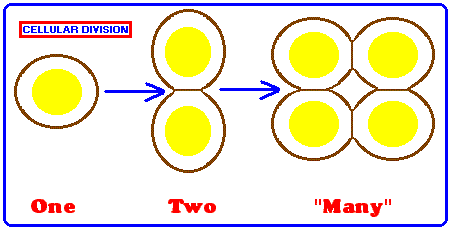
However, if we participate in the idea of an "uncertainty principle" of where to begin but nonetheless begin our count after the initial observation of the cell's presence in terms of subsequent cell division activity, the first three divisions create a "2- 4- 8" scenario:

The "8" is not only in the third position of order, but it is made up of a sequence containing two "3s" and one "2", instead of providing us with three "3's", (3- 3- 3)... suggesting this is either a regulated stop in biological activity brought on by environmental pressures, or that it is an end-point that is reached and can not be breached. And even if we were to assign the numerical value of "9" to each of the 12,123,123 places, it would be less than a hundred million: (99,999,999). However, if it is a code of sorts, than the placement of the "2" may not be in a total binary order. In other words, though the above image shows a 2 by 2 arrangement of cells, this perspective may be an imposition of a binary frame of mind. A trinary frame of mind would see three "3s" and one "2", with the added feature of alternatively arranging the set-up as a 3 X 3 X 2, 2 X 3 X 3, or 3 X 2 X 3. A binary perspective would not be induce to consider a "three pattern", though it might use a singularity. And if one did consider a "one" value from a "three" perspective, we would have a different sequence such as 1- 2- 3- 2 or its varieties. Using a "four" or quaternary orientation would only provide a binary "4- 4".
Subject page first Originated (saved into a folder): Thursday, November 13, 2014... 5:50 AM
Page re-Originated: Sunday, 24-Jan-2016... 08:51 AM
Initial Posting: Saturday, 13-Feb-2016... 10:59 AM
Updated Posting: Sunday, 23-June-2019... 2:25 PM
Herb O. Buckland
herbobuckland@hotmail.com